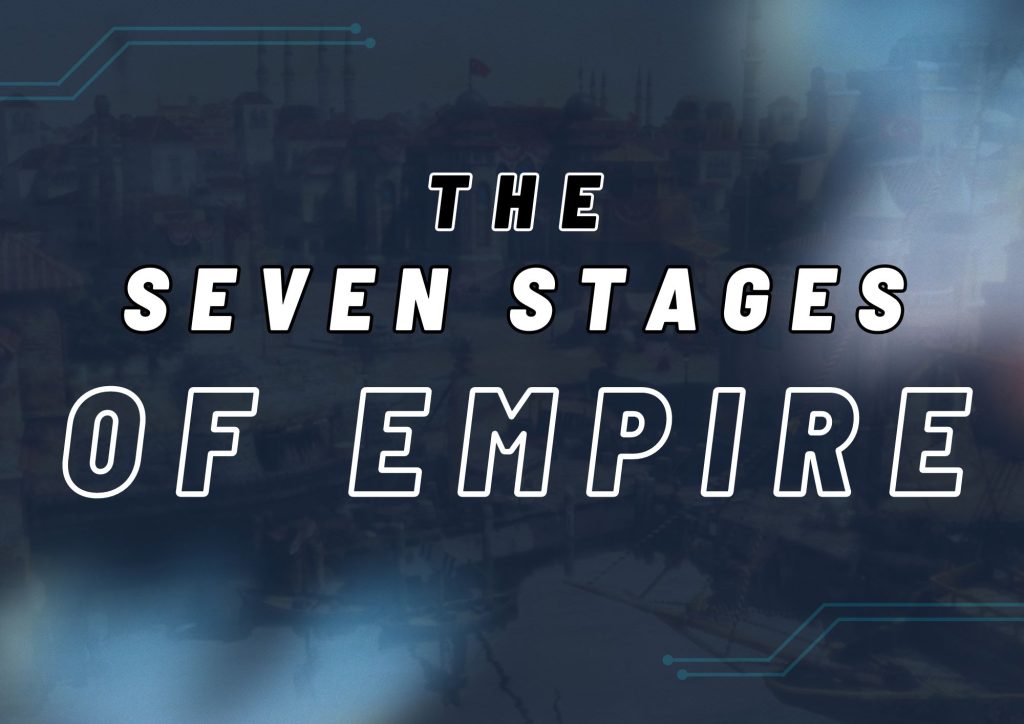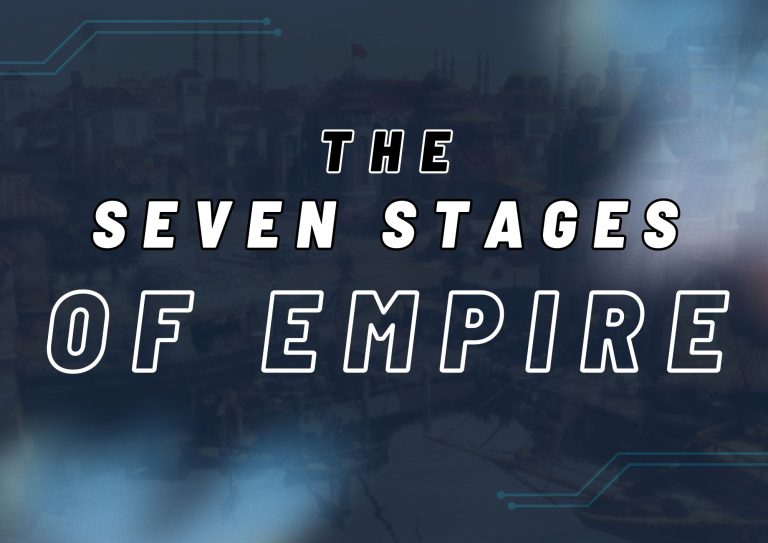The seven stages of empire is a cycle that runs on a long-term basis and society is switching between high-quality money and large amounts of currency. The cycle always concludes with gold emerging as the ultimate winner against depreciating currencies.
Mike Maloney coined this concept which is similar to the British soldier, writer and lecturer, Sir John Glubb. He (Sir John) researched the history of eleven empires, beginning with the Assyrians in 859 B.C. and ending with the British in 1950 A.D. He concluded that all empires experienced a similar pattern of growth and decline, broken down into seven stages.
- The Age of Pioneers (Outburst): A time of new explorers and adventurers
- The Age of Conquests: A time of conquering and expanding
- The Age of Commerce: A Time of Trade and Business
- The Age of Affluence: A Time of Prosperity and Wealth
- The Age of Intellect: A Time of Knowledge and Wisdom
- The Age of Decadence: A time of decline and moral decay
- The Age of Decline and Collapse: It’s a period of death and destruction.

Winston Churchill once said that the more you look back at the past, the more you can see the future. People normally repeat those mistakes they have made because they learn nothing from history. Through the study of history, covering many decades, centuries, and even longer, you become aware of repeating patterns. These patterns may go a long way in helping us understand the present trends and directions, since as history has it, history usually repeats itself. Through exploration of the past, we might get insights about what the future may bring. We continuously make the same mistakes.

The 7 Stages of Empire
At the moment, we are repeating the same mistakes that brought doom to the Athenian civilization. We are undervaluing our money and spending more of what we earn. This money finances large-scale investments, such as infrastructure projects and being involved in wars are . At its peak, At the height of its power, Athens seemed to have suffered from arrogance, which eventually contributed to its fall. They may have felt invincible and incapable of making mistakes. They ultimately paid the price by destroying their society.
Stage 1: Establishing Stable Currency
Initially, a country begins with a stable form of money, such as gold, silver, or currency tied to gold or silver reserves. In the period of the classical gold standard, the value of every unit of currency was based on the corresponding amount of gold which is stored in the Treasury. In the United States, a $20 paper note could be exchanged for $20 worth of gold, demonstrating that the paper note represented currency while gold functioned as money. Without this direct link, governments would have no incentive to hold gold reserves and issue currency backed by gold.

Stage 2: Public Works Programs – Building the Nation
A country starts to take on more economic responsibilities by adding more public works projects as it grows economically and socially. In 1933, President Roosevelt started implementing major public works programs aimed at fighting the Great Depression. To accomplish this task, he increased the dollar price of gold from $20.67 to $35. He then took it a step further by stopping the exchange of paper money for gold and making it illegal for private individuals to own gold. Gold certificates were no longer printed (although silver certificates that could still be exchanged for silver continued until the 1960s). Essentially, Roosevelt transformed America into a welfare state. He increased the amounts of tax money collected and spent for the public good—a situation that has continued to the present day.

Stage 3: Bretton Woods – Political power increases
The growth in economic wealth goes hand in hand with the growth of a country’s political power. Therefore, the country spent sharply on a big military to defend this growth.
During both wars, many young men in Europe left farming to become soldiers. Factories shifted from making consumer goods like toasters to producing weapons like machine guns. Car factories started making tanks instead. As a direct consequence, the United States became the dominant supplier of consumer goods and food grains to Europe which had to be paid in gold.
World war two benefited the United States economy because it was not geographically fought within its borders. They did not have to rebuild. As a result, by the end of the war, the US possessed 2/3 of the world’s gold, while Europe was overflowing with paper money.
This development triggered a series of meetings of representatives from various countries which took place in Bretton Woods, New Hampshire, in 1944. At this meeting, they agreed to create the new world monetary system – the Bretton Woods System. From that point on, the US dollar was designated as the dominant world currency. Within this new system, most of the world’s currencies were now supported by the US dollar, which in turn was backed by gold.
Stage 4: Endless Conflict
At some point, a nation decides to use its military. As a result, spending on the military grows rapidly. The USA was the only large industrial nation that was not too heavily damaged in the war after World War II. Eventually, the country transformed into a military/industrial state where war was a common occurrence. Many wars such as the Korean War, the Cold War, and the Vietnam War led to high costs for foreign conflicts. There were also huge expenses for being ready for a war at home.
Since the huge expenses were more than the income made through tax collection, the deficit was being financed through borrowing hence a deficit spending. The US started mixing cheaper metals with their coins. Apart from this, they also began printing money in large quantities. Other countries noticed. They asked the US to give them gold in exchange for their US dollars.
Stage 5: Eternal Inflation and Debt
In 1971, the Bretton Woods Conference’s international monetary system which was built on the gold-backed US dollar began to fail. The US failed to uphold the gold standard due to inflationary pressures. If President Nixon had continued to exchange gold for dollars until all the gold reserves were depleted, the global financial system would have collapsed. He resolved this by taking the country off the gold standard, which meant that foreign countries were unable to trade their dollars for a fixed amount of gold. Thus, gold’s price was no longer fixed but rather would move freely according to the laws of supply and demand.
The US dollar has become a pure fiat currency. It was no longer backed by any physical assets and could be printed without restriction, causing doubt about its value. To rebuild the trust, a special deal was made in 1974 between the US and Saudi Arabia. It was agreed that every oil transaction must only be done in US dollars, known as the petrodollar. Every country needed to have some dollars on hand because they all needed oil. This agreement made the US dollar the world’s main currency for global trade for quite a long time. It also led to unchecked inflation and the devaluation of currencies.
Stage 6: Where We Are Today
This is the current situation we are in. People can feel the decrease in buying power due to the increasing amount of money in circulation. This leads to distrust in the currency. It is a known fact from history that when governments print too much money, people and markets lose confidence in the currency.
The petrodollar system has been in place until now. However, China is now the largest importer of oil. It has begun its yuan-based oil trading exchange. These are signs that make the petrodollar’s future uncertain.
The foreign countries have become restless as their dollars continue to become worthless due to the United States’ spiraling trade deficit, estimated to be 773 billion U.S. dollars as of 2023. Such a trend can bring the prospect of trading oil in gold in the future.
In the past few years, the amount of money the US owes has increased drastically to more than $33 trillion, and the value of the currency has also been going up. One scenario is that the US will not pay the debts, which will cause prices to decline and the economy to plunge. There is also a possibility of hyperinflation as was the case of Zimbabwe and this could be worse. Eventually, we will have to make a tough decision.
We live in a world where trade is closely connected. If the dollar is not the dominant currency, it will have severe effects that will be felt not just by Americans but by people and countries worldwide. We are currently in the sixth phase out of seven phases of the empire.
Stage 7: Tomorrow
In the last stage of an empire, the currency completely fails. People rush to invest in precious metals like gold and silver. The prices of gold and silver rise to absorb the large amounts of currency that are in circulation. There will be a redistribution of wealth. Those who held real money like gold and silver before the onset of the crisis will benefit.
Mike believes that a new monetary system will soon be introduced globally. He predicts a significant deflationary crash worldwide. Governments may resort to printing money excessively, leading to hyperinflation and a loss of trust in currencies. In such situations, history shows that people tend to revert to using gold and silver as forms of currency.
The nations/countries that have gone through financial issues will need to reestablish a reliable monetary system again. This could mean returning to the old gold standard or adopting new technologies such as cryptocurrencies. Who knows?
One thing is for sure: a major change in the financial system is on the horizon. There is no way to avoid it. It might be delayed, but it cannot be stopped. It is not possible to solve the issue at present. Your only options are to let it wipe you out or to gain from it. If you are reading about this for the first time, I advise you to conduct your research. As soon as you realize this, you will be able to see the big picture and how the world, as of now, looks. If you need some good resources to start with, I suggest watching Mike Maloney’s Hidden Secrets of Money series.
Takeaways
In summary, the Seven Stages of Empire are:
- Stage 1: An empire begins with a strong currency backed by gold and silver.
- Stage 2: The state uses this money to develop the country and to provide social welfare programs.
- Stage 3: Political power increases, leading to large military and defensive measures. This money is now used to fund massive militaries.
- Stage 4: The state employs its military in war, thus spending and taxing more.
- Stage 5: To cover costs, the government devalues its currency, creates unlimited quantities of fiat money, and borrows funds.
- Stage 6: This debasement in currency is sensed by the general population. The public loses trust in the government and currency due to inflation or hyperinflation.
- Stage 7: The population begins to transfer their riches away from the currency into assets like gold and silver. The selling price of the precious metals skyrockets. This move indefinitely collapses the currency. Wealth transfers from the people who have it in the form of currency to the people who have it in the form of money.
Conclusion
The idea of The Seven Stages of Empire shows how societies go through a cyclical pattern in society’s relationship with money and currency. History provides us with a piece of clear evidence that civilizations usually commit the same mistakes which eventually lead to the debasing of currencies ending in their collapse. Through the analysis of past developments, we can develop more competence in terms of predicting future phenomena and getting ready for the forthcoming storms in the financial domain. While we advance through the empire’s stages, from a solid currency to its eventual collapse, we must stay vigilant and consider alternative strategies to protect our wealth such as investing in gold and silver. The changing economy might institute a new world monetary system. Therefore, adequate strategic planning going forward will help to minimize risks and take advantage of possible changes and opportunities.


